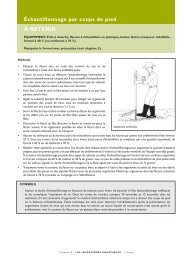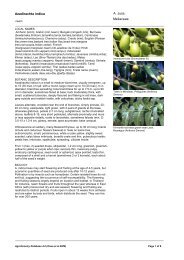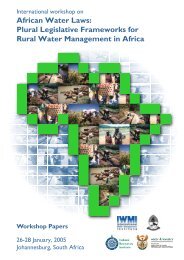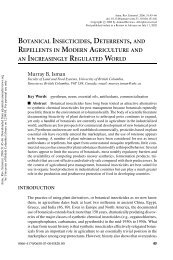Meteorological methods: temperature; humidity; rainfall; wind speed
Meteorological methods: temperature; humidity; rainfall; wind speed
Meteorological methods: temperature; humidity; rainfall; wind speed
Create successful ePaper yourself
Turn your PDF publications into a flip-book with our unique Google optimized e-Paper software.
WIND SPEED AND DIRECTION<br />
Wind-sock Method<br />
• Suspend a <strong>wind</strong>-sock on a tall pole that is<br />
unobstructed from the <strong>wind</strong> by buildings,<br />
trees, etc. Note the direction of <strong>wind</strong><br />
using a compass. Note that direction is<br />
measured in degrees so a <strong>wind</strong> from the<br />
east (easterly) is recorded as 90º, and<br />
from the south-east as 135º.Take readings<br />
in the morning and afternoon.<br />
Wind vane Method<br />
• A more accurate way is to use a <strong>wind</strong> vane, on a 6–10 ft (1.8–3.0 m) pole, connected to a meter or<br />
data logger. Recordings can be averaged daily and plotted as a radial diagram (example Figure 1.16 in<br />
chapter 1).<br />
Anemometer Method<br />
• Measure <strong>wind</strong> <strong>speed</strong> in an unobstructed<br />
area. Hold the anemometer or pitot gauge<br />
tube at arm’s length and read off the <strong>wind</strong><br />
<strong>speed</strong> in kilometres per hour.<br />
• Some gauges will give a number against the<br />
pith ball path that is converted on a table<br />
to kilometres per hour.<br />
• Daily statistics can be more easily<br />
obtained from an electronic anemometer<br />
wired to a meter/data logger.<br />
• Repeat at the same time each day.<br />
Beaufort Wind type<br />
Force<br />
0 Calm, no <strong>wind</strong><br />
1 Light air<br />
2 Light breeze<br />
3 Gentle breeze<br />
4 Moderate breeze<br />
5 Fresh breeze<br />
6 Strong breeze<br />
7 Moderate gale<br />
8 Fresh gale<br />
9 Severe gale<br />
10 Whole gale<br />
11 Storm<br />
12 Hurricane<br />
Anemometer<br />
Wind<br />
Anemometer<br />
taped to post<br />
Post<br />
P robable terrestrial features<br />
Sock<br />
Pole<br />
The Beaufort (Wind Force) Scale: approximate <strong>wind</strong> <strong>speed</strong> using visual cues<br />
90–120 cm<br />
Smoke rises vertically<br />
Smoke drifts down<strong>wind</strong>; <strong>wind</strong> vane static<br />
Wind felt on face; leaves rustle; <strong>wind</strong> vane<br />
moves<br />
Leaves and twigs in constant motion; <strong>wind</strong><br />
extends light flag<br />
Dust and loose paper raised; small branches<br />
move<br />
Small trees in leaf begin to sway; white crests<br />
form on inland water<br />
Large branches in motion; telephone lines<br />
whistle<br />
Whole trees in motion; walking against <strong>wind</strong><br />
requires effort<br />
Twigs break off trees; progress on foot<br />
impeded<br />
Slight structural damage to buildings<br />
(slates/tiles removed)<br />
Trees uprooted; considerable structural<br />
damage to buildings<br />
Rarely experienced; widespread destruction<br />
Very rare and dangerous<br />
Chapter 5 E N V I R O N M E N TA L PA R A M E T E R S I. Grant<br />
Open<br />
end<br />
Wind-sock<br />
Cups<br />
Cable to<br />
data logger<br />
Knots Metres per<br />
second<br />
0 0<br />
1–3 1–5<br />
4–6 7–10<br />
7–10 12–18<br />
11–16 20–29<br />
17–21 31–38<br />
22–27 40–49<br />
28–33 51–60<br />
34–40 62–73<br />
41–47 74–85<br />
48–55 87–100<br />
57–65 104–116<br />
68+ 118+











